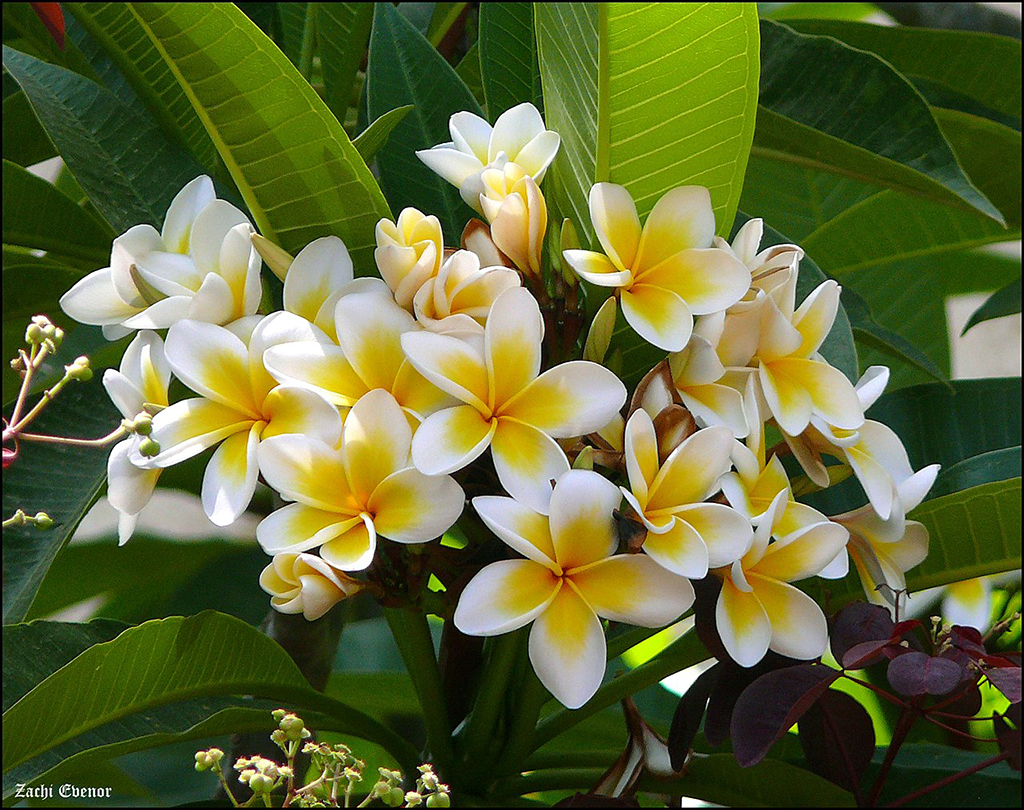
Nauru
Frangipani
Plumeria

General Description / Cultural Significance
The small Micronesian island nation of the Republic of Nauru has low biodiversity. The coast is dotted with mostly Coconut Palms and Pandanas. The island is surrounded by coral reefs, which give the island a small buffer against the rising sea. Within the country’s low growing vegetation, two species of fragrant, vibrant Frangipani bloom, Plumeria obtusa and Plumeria rubra. Though they do not grow as plentifully in Nauru as on other Polynesian islands, Frangipanis are no less a crucial part of Nauruan history and identity.
Frangipani species vary greatly in size from a small shrub to a tree as tall as thirty feet with round canopies of rich, glossy green leaves. Both species are grown in yards and home gardens for their beauty and practical use. Tubular, pin-wheel shaped flowers bloom from March to October in fantastic displays of color. The flowers of P. obtusa tend to grow all white with a striking yellow center, or “eye.” The blooms are picked fresh and woven into garlands worn during celebrations and various ceremonies. P. obtusa petals are then dried in the bright Nauru sun and their scent marinated in coconut oil for many personal care considerations.
P. rubra has flourished in Nauru longer than P. obtusa, and is famous for its range of vibrant-colored flowers, from yellow to pink to a deep red. While these flowers are also crafted into garlands, P. rubra has many additional medicinal benefits. Leaves of the tree are mixed with coconut oil to cure fevers. Medicinal and aromatic plant documents describe the breath of P. rubra’s main healing abilities as a purgative, rubefacient, errunenagogue, febrifuge and diuretic. In both traditional and modern medicine, this powerful plant has been used to treat dysuria, diarrhea, itchiness of the skin, bronchitis, coughs, asthma, fever, dysentery, blood disorders, and tumors. The leaves of P. rubra are used in the healing of ulcers, leprosy, inflammation, and rheumatism. P. rubra root bark is bitter and pungent, with a warming physical effect and the ability to serve as a laxative.
Frangipani flowers are highly fragrant in nature and their scent is recognized by all the inhabitants of the island. Frangipani is utilized by the high-end perfume industry for its sweet, soft scent. The steam-distilled essential oil is used in professional and personal aromatherapy for its aphrodisiacal, stress alleviating, and mood lifting abilities.
Climate Change / Conservation Status
Nauru has long suffered extensive environmental degradation. The country was aggressively mined for phosphate throughout the twentieth century, which destroyed most of the island’s original forest and arable land. This destruction of land combined with geographic isolation and lack of fresh water has ensured that the country must depend on imports for basic health, energy, and survival needs. Climate change is expediting coastal erosion and exposing Nauru to more climatic hazards such as increased drought, sea level rise, higher air and ocean temperatures, a decline in coral reef health, intense storms, and ocean acidification. These impacts are placing Nauru, a country already geographically isolated, environmentally vulnerable, and highly dependent on others for survival, in an even more difficult position to prosper. The government is looking to international climate resiliency programs to relieve the growing food and water scarcity spreading across Nauru.
In Nauru, Plumeria species primarily grow in house yards and village gardens and have been lucky in their saline-tolerance which has kept them safe from the effects of encroaching sea levels. However, no plant, even ones which traditionally thrive in sandy soils, can withstand habitat disappearance as the ocean consumes Nauru’s coastline. Frangipanis rely on birds, insects, and other fauna which are drawn to the flower’s seductive scent released at night for pollination and seed dispersal. As temperatures change, seasonal signals between the Frangipani and its pollinators are becoming less clear, disrupting the cycles which keep flora and fauna in sync.
Rehabilitation is not just necessary to restore ecosystems stolen by extractive mining, and now climate change. It is critical to revitalize a nearly disappeared indigenous culture tied to the country’s land and sea. Local people and governments see this as an opportunity to adapt to climate change, develop sustainability on the island, and reinvigorate a once vital connection between the Nauruan people and their environment. This means not just enjoying Frangipani in the homestead, in all its aroma, medicinal benefits, and beauty, but walking out onto the beach or into the forests of Nauru and witnessing the beautiful blooms thriving in the wild as they once did.
Alternate Names
Melia (Hawaiian)
White Frangipani (Plumeria obtusa)
Demeria (Plumeria obtusa)
Pwohmaria (Pohnpeian, Plumeria obtusa)
Temple tree (Plumeria rubra)
Graveyard tree (Plumeria rubra)
Arabaneit (Plumeria rubra)
Sources
Criley, R.A., 2005. Plumeria in Hawai‘i. College of Tropical Agriculture and Human Resources, University of Hawai‘i at Mänoa.
Flora & Fauna Web, 2022. Plumeria rubra. Singapore Government Agency. [website]
Goswami, P., Verma, R.S. & Padalia, R.C., 2016. Chemical Constituents of Floral Volatiles of Plumeria rubra L. from India. Medicinal & Aromatic Plants. DOI:10.4172/2167-0412.S3-005
Healing Ayurveda, 2022. Frangipani Essential Oil. FairOrganic. [website]
Nations Encyclopedia, 2022. Nauru- Flora and Fauna. Advameg, Inc. [website]
Office of Tourism, Nauru. This statement can be found on the World Sensorium original website.
Onotio, K., and Deiye, T., 2022. Nauru’s Biodiversity Strategy and Action Plan. Government of the Republic of Nauru. [website]
Ross, L., 2021. Frangipani. Garden Clinic. [website]
Republic of Nauru, n.d.. Intended Nationally Determined Contribution (iNDC) Under the United Nations Convention on Climate Change. Republic of Nauru. [website]
Thaman, R. R., 1992. Vegetation of Nauru and the Gilbert Islands: Case Studies of Poverty, Degradation, Disturbance, and Displacement. Pacific Science. 46(2): 128-158.
Whistler, W.A., Herbal Medicine in Samoa. Allertonia, 9(2):39–80.

